
Characiformes is an order of ray-finned fish, comprising the characins and their allies. Grouped in 18 recognized families, more than 2000 different species are described, including the well-known piranha and tetras.

The Orinoco is one of the longest rivers in South America at 2,250 kilometres (1,400 mi). Its drainage basin, sometimes known as the Orinoquia, covers 880,000 km2 (340,000 sq mi), with 76.3 percent of it in Venezuela and the remainder in Colombia. It is the fourth largest river in the world by discharge volume of water. The Orinoco River and its tributaries are the major transportation system for eastern and interior Venezuela and the Llanos of Colombia. The environment and wildlife in the Orinoco's basin are extremely diverse.
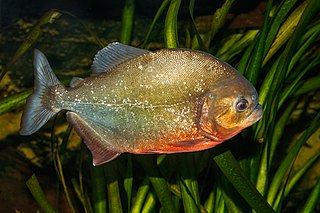
A piranha or piraña, a member of family Serrasalmidae, or a member of the subfamily Serrasalminae within the tetra family, Characidae in order Characiformes, is a freshwater fish that inhabits South American rivers, floodplains, lakes and reservoirs. Although often described as extremely predatory and mainly feeding on fish, their dietary habits vary extensively, and they will also take plant material, leading to their classification as omnivorous.

The São Francisco River is a large river in Brazil. With a length of 2,914 kilometres (1,811 mi), it is the longest river that runs entirely in Brazilian territory, and the fourth longest in South America and overall in Brazil. It used to be known as the Opara by the indigenous people before colonisation, and is today also known as "Velho Chico".

Ciudad Bolívar, formerly known as Angostura and St. Thomas de Guyana, is the capital of Venezuela's southeastern Bolívar State. It lies at the spot where the Orinoco River narrows to about 1 mile (1.6 km) in width, is the site of the first bridge across the river, and is a major riverport for the eastern regions of Venezuela.
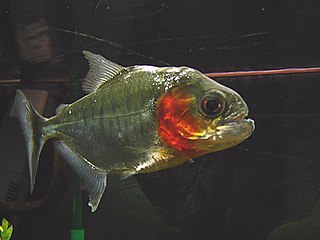
Serrasalmus is a genus of piranhas. They are collectively known as pirambebas; the "typical" piranhas like the piraya piranha are nowadays placed in Pygocentrus. Like all piranhas, Serrasalmus are native to South America.
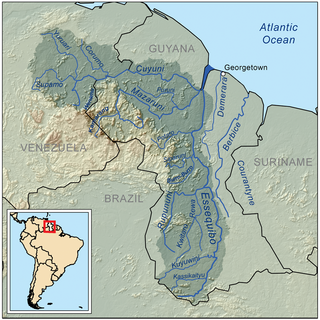
The Rupununi is a region in the south-west of Guyana, bordering the Brazilian Amazon. The Rupununi river, also known by the local indigenous peoples as Raponani, flows through the Rupununi region. The name Rupununi originates from the word rapon in the Makushi language, in which it means the black-bellied whistling duck found along the river.

Pygocentrus is a genus of the piranha family Serrasalmidae. All species are native to tropical and subtropical South America. All the species are predatory, scavengers and may form large schools. The famous red-bellied piranha, Pygocentrus nattereri, is one of four species in the genus.
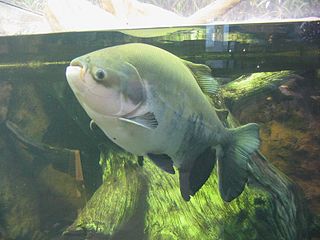
Pacu is a common name used to refer to several species of omnivorous South American freshwater serrasalmid fish that are related to the piranha. Pacu and piranha do not have similar teeth, the main difference being jaw alignment; piranha have pointed, razor-sharp teeth in a pronounced underbite, whereas pacu have squarer, straighter teeth and a less severe underbite, or a slight overbite. Pacu, unlike piranha, mainly feed on plant material and not flesh or scales. Additionally, the pacu can reach much larger sizes than piranha, at up to 1.08 m in total length and 40 kg (88 lb) in weight.

The sharp-snouted piranha is a species of serrasalmid endemic to Peru. It is part of the S. rhombeus complex. It reaches a maximum size of around 7 inches (18 cm). Individuals often exhibit a red throat, similar to that of Pygocentrus nattereri. It is also known as ruby-throated diamond piranha or "ruby-red piranha"; the latter name is also used for the speckled piranha.

The Serrasalmidae (serrasalmids) are a family of characiform fishes, recently elevated to family status. It includes more than 90 species. The name means "serrated salmon family", which refers to the serrated keel running along the belly of these fish. Fish classified as Serrasalmidae are also known by these common names: pacu, piranha, and silver dollar. These common names generally designate differing dental characteristics and feeding habits.

The red-bellied piranha, also known as the red piranha, is a species of piranha native to South America, found in the Amazon, Paraguay, Paraná and Essequibo basins, as well as coastal rivers of northeastern Brazil. This fish is locally abundant in its freshwater habitat. They are omnivorous foragers and feed on insects, worms, crustaceans and fish. They are not a migratory species, but do travel to seek out conditions conducive to breeding and spawning during periods of increased rainfall. Red-bellied piranhas often travel in shoals as a predatory defense, but rarely exhibit group hunting behavior. Acoustic communication is common, and is sometimes exhibited along with aggressive behaviors. Through media influence, the red-bellied piranha has developed a reputation as a ferocious predator, though this is not actually the case. They are a popular aquarium fish.

Pristobrycon is a genus of piranhas from the Orinoco and Amazon Basins, as well as rivers in the Guianas.
Palometa is a name used for several species of fish:

Trachinotus goodei, the palometa, is an ocean-going game fish of the family Carangidae. Other common names include banner pompano, camade fish, cobbler, gafftopsail, great pompano, joefish, longfin pompano, old wife, sand mackerel, streamers jack, wireback. This fish is native to the western Atlantic Ocean from Massachusetts to Bermuda to Argentina. It can be found in the Gulf of Mexico and the Caribbean Sea.
Pristobrycon striolatus is a species of serrasalmid fish.
Armando Becker is a retired male basketball player from Venezuela, who played as a forward during his career. He competed for the Venezuela national basketball team at the 1990 FIBA World Championship and at the 1991 Pan American Games.

Pygocentrus cariba or black spot piranha is a species of piranha native to the Orinoco River basin lowlands and the Llanos region in Venezuela and Colombia. This species can reach a total length of 27.9 centimetres (11.0 in). It is popular as a game fish.
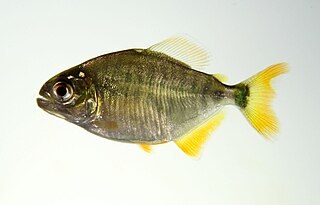
Pygopristis denticulata is a species of piranha. These fish are part of the group Ostariophysi, a large group of freshwater fish that includes minnows and catfishes. It is a rare South American fish found in the Orinoco River basin, north and eastern Guiana Shield rivers, and tributaries of the lower Amazon River. Piranhas typically live in freshwater, but other specimens can be found elsewhere. Specimens of this species is frequently found in acidic clear or black waters. Piranhas are primarily known for being savage, flesh-eating fish, but they actually have broader diets. They usually feed on aquatic insects, small fish, and fruits.
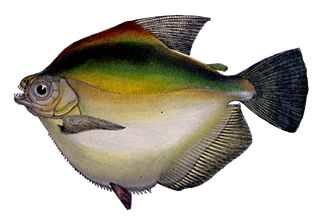
Mylossoma duriventre, the silver mylossoma, is a species of freshwater serrasalmid fish endemic to tropical and subtropical South America. It grows to a maximum length of about 25 cm (10 in) and a weight of 1 kg (2.2 lb). It is the subject of a local fishery, being known as palu in Brazil and palometa in Venezuela.














